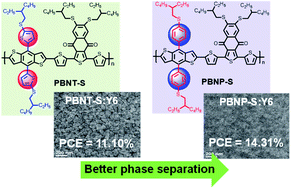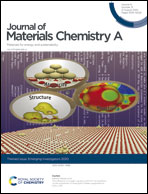Conjugated side-chain engineering of polymer donors enabling improved efficiency for polymer solar cells†
Abstract
Generally, molecular optimization is widely used to fine-tune the absorption features and energy levels of photovoltaic materials to improve their photovoltaic performance for polymer solar cells (PSCs). In this work, we demonstrate an example that the morphological properties can be effectively optimized by conjugated side-chain engineering on the benzo[1,2-b:4,5-b′]dithiophene (BDT) unit. The polymer donors PBNT-S with an alkylthio-thienyl substituent and PBNP-S with an alkylthio-phenyl substituent have identical absorption spectra and energy levels, while exhibiting significantly different morphological properties when blended with nonfullerene acceptor Y6. The PBNT-S:Y6 blend shows obviously excessive crystallinity with excessive domain sizes, while the PBNP-S:Y6 blend realizes better nanoscale phase separation. As a result, a notable power conversion efficiency (PCE) of 14.31% with a high fill factor (FF) of 0.694 is achieved in the PBNP-S:Y6-based device, while the PBNT-S:Y6-based device yields a moderate PCE of 11.10% and a relatively low FF of 0.605. Additionally, PBNP-S shows great potential in semitransparent PSCs, and the PBNP-S:Y6-based semitransparent PSC achieves an outstanding PCE of 11.86%, with an average visible transmittance of 24.3%. The results demonstrate a feasible strategy to manipulate the morphological properties of blend films via rational molecular optimization to improve the photovoltaic performance.

- This article is part of the themed collection: Journal of Materials Chemistry A Emerging Investigators


 Please wait while we load your content...
Please wait while we load your content...